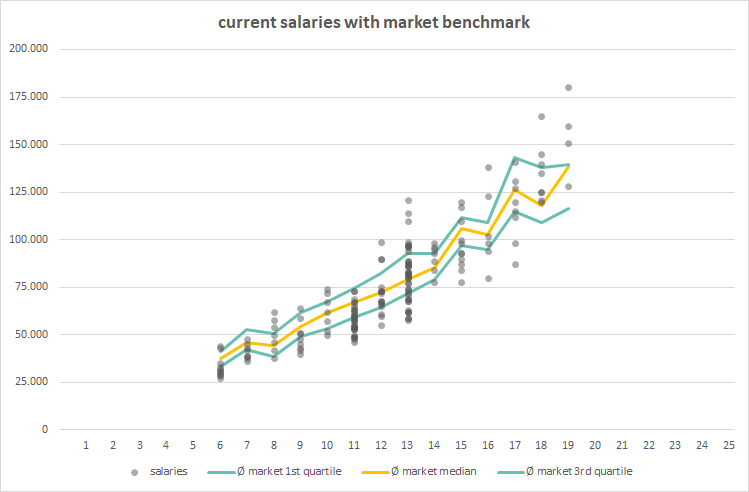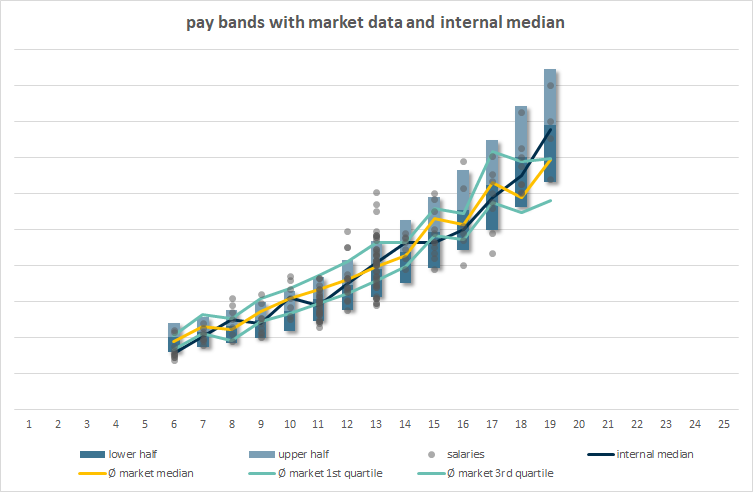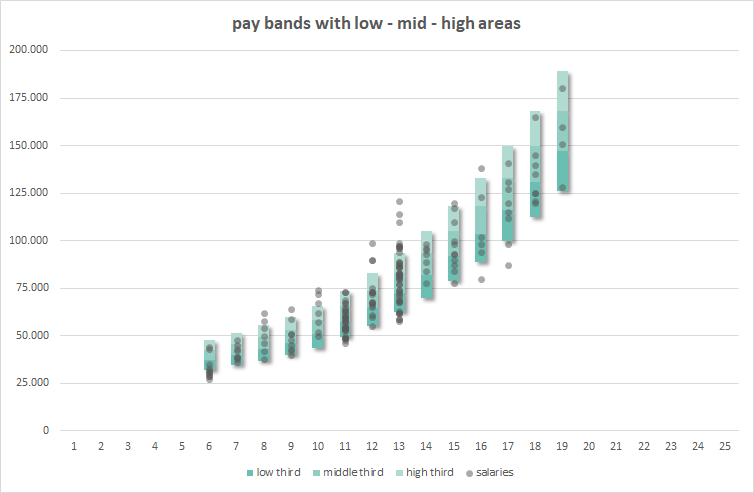Compensation analytics and compensation structuring are the fundamental tools of pay management. They involve analysing and understanding the current distribution of salaries, deciding on pay levels, fixing rates of pay and developing and operating grade-based pay structures.
Grade Structures
A grade structure consists of a hierarchy of levels into which jobs that are broadly comparable in their requirements are placed.
gradar is a modern and affordable job grading tool that analyzes and evaluates jobs in three distinct career paths and 25 grades:
- Individual Contributors such as non-skilled and semi-skilled laborers, skilled specialists, professionals and strategic experts.
- Management roles such as team leaders, middle management and top management functions.
- Project Management roles with the core objective of coordinating, planning and distributing personnel, resources and budgets.
Experts, "Gurus"
Professionals
Skilled Labor
Un-skilled / Semi-skilled Labor
The Grade is a result of the project's dimensions: Timeframe, budget, leadership span, complexity, ...
General Management
Top Management
Middle Management
Supervisory
Management /
Team Leadership
Individual Contribution
Project Management
Management
Grade and Pay Structures
A grade structure becomes a grade and pay structure when pay bands (also called brackets, ranges or scales) are attached to each grade or level. In other words, a pay structure describes an organization's willingness and ability to pay.
Pay Bands
Formal graded pay structures are defined by the number of grades they contain, as well as the span or width of the pay bands attached to each grade.
Pay Bands
Pay bands are defined by the difference between the lowest and the highest monetary value set for each grade or level.
The structures define the different levels of pay for jobs or groups of jobs from job families. They do this with reference to external relativities established by market rate surveys and internal value determined by job evaluation. They provide scope for pay progression in accordance with performance, contribution or service.
As a result, an employee’s minimum salary is at least on the respective pay band minimum and, ideally, there are no outliers below or above the pay band. When pay bands are modelled in a grade structure, they are typically narrower than if they were to modelled for a broad job category such as executives or subject matter experts - known as broadbanding.
The progression of employees within a salary band should take into account various factors such as budget [cost of living + merit], compa-ratio within the pay band, resignation risk, talent potential and more.
Pay Groups
In some compensation structures, reference points may be placed within the bands to indicate the height of pay for jobs depending on the grade and tenure. These systems are called pay groups and are quite typical for collective bargaining agreements as they show monthly wages.
Pay Groups
Segmentation of Pay Structures
There may be a single grade and pay structure covering the entire organization. Occasionally, segmentation is based on job families, involving the use of separate pay bands or bonus plans for different categories of staff so that special requirements can be catered for.
A typical approach is to develop a job family structure that has separate grade and pay structure for different groups of staff. The traditional form of segmentation is to have one structure for staff with salaries and another for manual workers with wages. The use of separate structures for white-collar and blue-collar job holders is becoming less common and is evident from recent updates of collective bargaining agreements across the globe.
The trend within these agreements is to harmonize non-analytical job evaluation methods with terms and conditions between different groups of staff as part of a move towards single status. This is further supported by pay equity legislation and an increasing need for skilled labor even amongst traditional blue-collar jobs.
Three Steps to Modelling Pay Bands
Modelling pay bands is not a science, it’s an art. Compensation structuring uses statistical methods alongside multiple information sources to design a structure that is appropriate to the culture, characteristics and needs of the organization and its employees. It follows an evidence-based practice, taking into account the following sources:
- Internal data from the evaluation and grading of jobs, alongside a statistical analysis of current salaries.
- Market benchmarks to assess the price of similar jobs in other organizations.
- Stakeholders’ values and concerns.
- The compensation practitioner’s professional expertise in designing pay structures.
Step 1: Analysis of the Current Salaries with Regard to the Distribution and Correlations of Salaries
To start the compensation analysis, we examine the grade-based distribution of salaries. This requires the evaluation of all the job holders’ functions, as well as matching the employees to their actual jobs.
Employee data must then be prepared for compensation analysis and modeling by extrapolating all part-time salaries, allowances and guaranteed payments to full-time-equivalent figures. With this, we’re able to compare relevant data which gives the most useful results.
We then use a simple scatter diagram to show the current distribution of salaries.
current salaries
Additionally, we run some simple descriptive statistics to learn more about the distribution of salaries. We consider the grade-based percentiles, such as the median, and the grade-based averages.

This information shows us where current salaries are closely distributed and where they are far apart. In this case, our distribution analysis shows - especially in grades 12 (49%), 13 (56%) and 16 (50%) - the salaries spread relatively widely.
For this purpose, the distance from the 10th to the 90th percentile (80% of employees) and, if required, the distance from the 5th to the 95th percentile are considered. The broader the distribution of salaries, the more challenging the modelling of salary bands and the management of salaries becomes.
We may use slightly more advanced statistics to view the correlations of different factors such as grade and height of salary. In this example, the analysis shows that there is already a strong, positive correlation between grade and salary level (r= 0.89).
Further options could be to look at salary and gender, salary and age or salary and job tenure. We could also use multivariate analysis and regression analysis to learn more about our population. The bigger the population, the higher its significance as the basis for an internal benchmark.
Step 2: Comparison of Current Salaries with a Market Benchmark
For the market benchmark of actual salaries, data from compensation benchmark surveys and collective bargaining agreements is used in a two-step process:
- Analysis of an individual job holder’s comparative ratio.
- Grade-specific aggregation of market benchmark prices.
gradar supports the automated matching of its grading results to benchmark positions from leading global compensation surveys and shows a strong correlation to existing collective bargaining agreements.
Learn More About Our Job Matching FeatureThe individual compa-ratio analysis compares an employee’s current salary with the market benchmark (e.g. median-based pricing). A compa-ratio is a measure of the relationship between actual and reference rates of pay as a percentage.
Compa-ratios can be used to learn about the overall market deviation - the relationship between market prices and actual rates of pay. An overall compa-ratio of 98% means that, on average, employees are paid 2% below the market reference point.

The aggregation of benchmark prices gives an overview of your employee population compared to the external benchmark. Using a population-based average of median and percentile values is a great way to take into account your organization’s specific job types and distribution of job holders.
We associate market pricing with job evaluation in order to develop a pay system that is internally equitable as well as externally competitive. That said, it can be difficult to achieve. Paying the competitive rate for a job can upset internal relativities as established by our analytical job evaluation.
Insight Into US-American and European Compensation Management Practices
There is a difference in the way US-American and European companies use job evaluation. In our experience, American companies often focus on the “price” of a job, whereas many European companies focus on the “value” of a job to determine a salary range.
The difficulty with the former is that many companies compare their jobs to the wrong levels in the benchmark surveys, resulting in significant pay budget losses. gradar dramatically enhances the American market job pricing strategy by ensuring jobs are levelled correctly. Removing subjectivity from the job analysis process saves the company a significant amount of money.
Step 3: Modelling Pay Bands
From the analysis of current salaries and market data, together with the knowledge of stakeholder values, the experienced compensation professional will be able to model pay bands and pay groups. They can also design hybrid solutions that enable the organization to exercise full control over the implementation of pay policies and budgets.

The salary bands are often designed with a +/- 20% spread around the grade-specific midpoint. The height of the midpoints depends on the results of the internal and external analysis, as well as the strategic goals of the company. A typical statement in an organization’s compensation philosophy is about the pay positioning. From a benchmarking perspective, the base pay positioning may be aimed at the market median, whereas the total target compensation positioning may be aimed at the upper quartile.

In some cases, such as broad-banded structures, more than two segments are used. A basic example is the use of an entry-level low third, a middle third for full achievers and a high third for top performers or long-tenured personnel.
There is no one-size-fits-all approach. No algorithm will build the perfect pay structure. Ultimately, it is always a decision driven by an organization’s needs for flexibility and continuous development in rewarding performance and an increase in skill.
What’s the Evidence for Compensation Structuring?
General pay satisfaction is more strongly related to distributive justice than to procedural justice. Without structures, there can be no distributive or procedural justice. Pay bands and job evaluation may play a big part in achieving equity, fairness, consistency and transparency when managing gradings and pay as well as avoiding discrimination and biased-decision making.
would you like to know more?
register now for our free evaluation version and try gradar for free!



